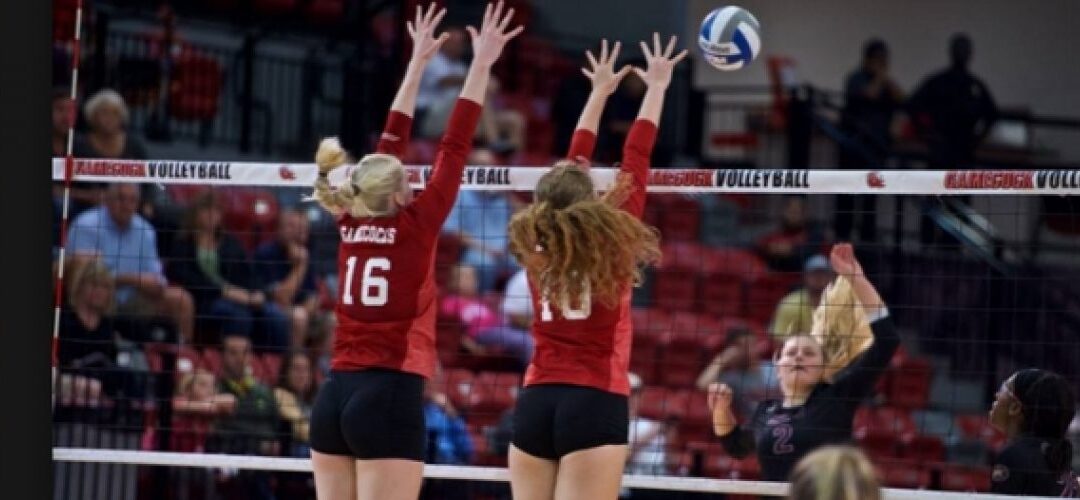(Photo courtesy of Jacksonville State University volleyball)
By Paul Culp, MA (Oxon.), CFT, GCDF, CCSP
Nationwide and across all sanctioning bodies, female athletes on scholarship receive more funding per person, on average, than male athletes.
Last month we looked at athletic scholarships (The “How Many” and “How Much” of Athletic Scholarships), seeking a realistic perspective on how widely available and how valuable they actually are. One of the surprises was the discovery that female scholarship athletes receive more funding per person, on average, than male scholarship athletes do. The pattern is consistent across the NCAA, NAIA, and NJCAA.
What is less surprising is that the disparity is especially apparent in volleyball. Men’s volleyball simply is not a highly popular sport, and the financial aid situation reflects that, whereas women’s intercollegiate volleyball represents ample opportunity for those who know how to pursue it.
About 6 percent of female high school volleyball players go on to play at the collegiate level.
According to Scholarshipstats.com, there are about 61,000 male high school volleyball players in the U.S. and nearly half a million female players. There are about 2,700 male college volleyball players and 10 times that many females, on 10 times as many teams. The odds of a male making an NCAA or NAIA roster are 29:1, versus 23:1 for a female athlete, and at NCAA Division I level the odds are 173:1 and 92:1, respectively.
Approximately 6 percent of female high school volleyball players go on to play at the college level, as opposed to 4 percent for men. A little over 1 percent of females make it to NCAA Division I, versus .6 percent for men.
Although not all schools with both men’s and women’s programs award the women more money per athlete, the practice is common. Even where the men receive more on average, far less total money is being spent, inasmuch as scholarship limits per team are much more generous for women: 4.5 for men versus 12 for women in NCAA Division I, 4.5 versus eight in Division II, and zero versus 14 in the NJCAA. The NAIA allows eight per team regardless of gender.
Note that the limits are per team and not for each cohort of incoming freshmen. The more athletes graduating or otherwise leaving the program in a given year, the more scholarships are available for new talent. With an average team size of 16 in the NCAA, 18 in the NAIA, and 13 in the NJCAA, only a small percentage of female volleyball players overall are walk-ons, except in the NAIA.
Scholarshipstats.com reports that during the 2016 fiscal year the average scholarship per team for women in NCAA Division I was $31,138, with a high of $63,281.
To put that in perspective, the national average cost of tuition and fees is now about $35,000 per year at private colleges, $10,000 for in-state residents at state institutions, and $26,000 for out-of-state residents attending state schools.
Not all rides are free.
It’s important to be aware that only in Division I is women’s volleyball a “head count” sport, meaning that all scholarships are full scholarships. In all other divisions in which scholarships are available, women’s volleyball is an “equivalency sport,” meaning that coaches may divide the value of the available scholarships between as many athletes as they like. (Men’s volleyball is not a head count sport at any level.) Note also that athletic scholarships do not exclude other forms of financial aid that could be used as supplementation.
While Division III programs do not offer athletic scholarships, volleyball can still be a ticket to financial aid. As we said in our previous article on the topic, “involvement in sports can be part of an extracurricular resume that colleges consider strongly in making decisions about whom to admit and whether to bestow financial aid. Thus it is possible, even without athletic scholarships, for athletic prowess and the desire to perform at the college level to play a role in the acquisition of financial aid for student-athletes applying at Division III schools.”
Getting recruited requires the right tools, and mastery of a complex process.
Athletes who want to be in the illustrious 6 percent who play at college level, or even the fabled 1.1 percent who play in Division I, should be advised that the road to recruitment is not an easy one. Laurie Lokash, now in her thirty-fifth year as head coach at Division II Slippery Rock University and the eighth-winningest active coach in the nation, warns that playing on a club team–which 91 percent of female college volleyball players have done–is far from a guarantee of being discovered:
“I think many people are surprised by the fact that only 6 percent of the current club/high school population goes on to play collegiate volleyball. I think many families believe that playing club volleyball is an automatic ticket to playing at the next level.”
No matter how talented you are, having your talent on display in plain sight probably will not be enough. Most volleyball players believe they will attract the notice of coaches who watch them perform in tournaments, but the brute fact is that the attention of those coaches is greatly diluted by the presence of so many athletes in one place at one time. Standing out as an individual is an enormous challenge.
Women’s volleyball scholarships, like other scholarships, are best pursued with expert help.
The Coaching Educator has nearly a decade of experience helping student-athletes pursue their dreams at all levels of intercollegiate sports. We help them keep abreast of the regulations, timetables, procedures, and personal contacts that are essential components of a successful recruiting process. Our special services for athletes also include design and construction of the websites that are now such an important factor in presenting an athlete in the best possible light. If you are interested in pursuing an athletic scholarship, we recommend that you start early.
To learn more about our philosophy and capabilities, be sure to watch our free webinars, listen to our podcasts, sign up for our four-week College App Boot Camp, consider our Ultimate Programs and our special services for athletes and performing-arts students, and book a consultation to hear what we can do for you and how we do it. Keep reading this blog, and look for us on social media (see links below) as we keep our clients and admirers advised of new developments in our effort to help students get into and succeed at the right school.
Paul Culp is certified as a global career development facilitator and writes about college admissions, college costs, financial aid, and college life in general for The Coaching Educator team. A former journalist and corporate ghostwriter who now operates Shenandoah Proofreading, Editing & Composition Services (SPECS), he has also been a humanities teacher at all levels from university down to sixth grade. Paul has degrees from Oxford University, Jacksonville State University, and Samford University, and also is certified as a fitness trainer.
Recommended Reading About Athletic Scholarships
Culp, Paul. “Basketball Scholarships by the Numbers,” The Coaching Educator, 4 April 2019, http://tce.local/2019/04/04/basketball-scholarships-by-the-numbers/
Culp, Paul. “The ‘How Many’ and ‘How Much’ of Athletic Scholarships,” The Coaching Educator, 18 September 2018, http://tce.local/2018/09/18/the-how-many-and-how-much-of-athletic-scholarships/
Culp, Paul. “The ‘How To’ of Athletic Scholarships Explained,” The Coaching Educator, 24 November 2018, http://tce.local/2018/11/24/the-how-to-of-athletic-scholarships-explained/
Culp, Paul. “Lacrosse Scholarships by the Numbers,” The Coaching Educator, 6 December 2018, http://tce.local/2018/12/06/lacrosse-scholarships-by-the-numbers/
Culp, Paul. “Ten Unusual Athletic Scholarships, The Coaching Educator, 8 March 2019,
Culp, Paul. “Why Scholarship Athletes Quit,” The Coaching Educator, 25 February 2019, http://tce.local/2019/02/25/why-scholarship-athletes-quit/
Culp, Paul. “Women’s Soccer Scholarships by the Numbers,” The Coaching Educator, 23 October 2018, http://tce.local/2018/10/23/womens-soccer-scholarships-by-the-numbers/?fbclid=IwAR1tqZ-uyy8Kjw8krJDl–ERyuxUF_lt2uVfcqFqbNtmQDDTQvvBK7EOhJ8
Support smart students and spread the word:
https://www.facebook.com/thecoachingeducator
https://www.youtube.com/user/KeirinCarroll
https://twitter.com/TCEducator
https://www.instagram.com/thecoachingeducator
https://www.linkedin.com/company/thecoachingeducator
Follow us on:
YouTube: https://tinyurl.com/yy5yssq8

